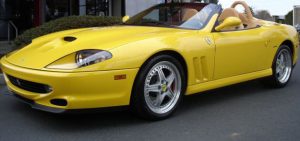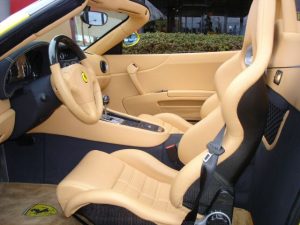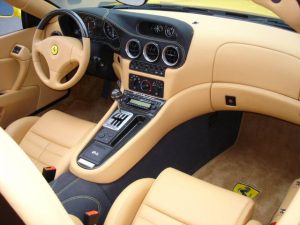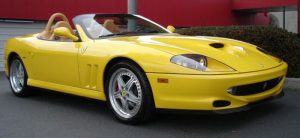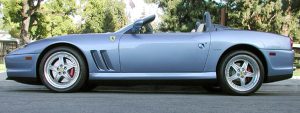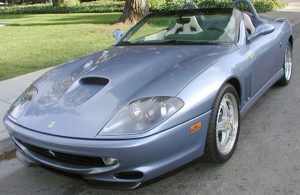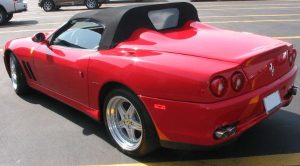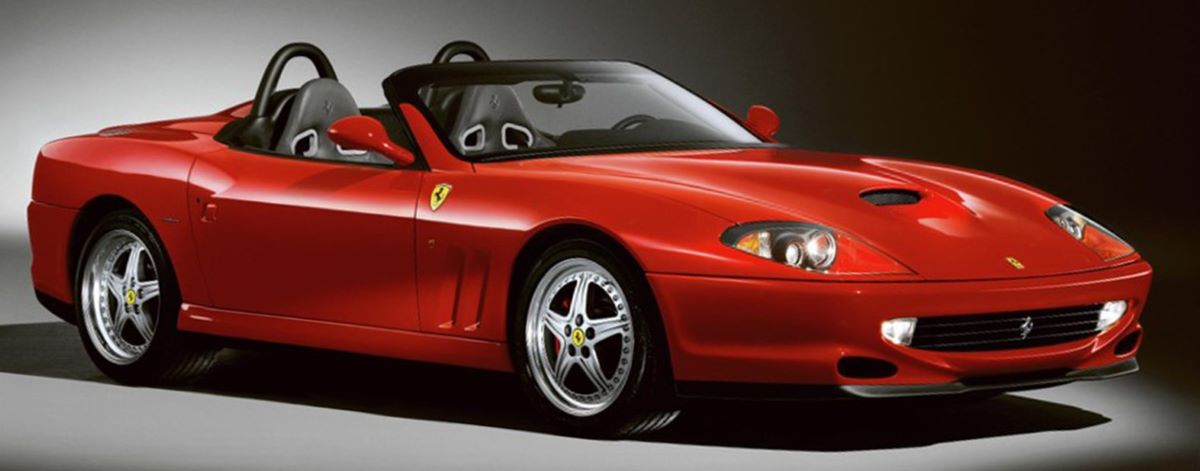
Unveiled at the Paris Show in 2000, the 550 Barchetta Pininfarina was so named to commemorate the 70th anniversary of Ferrari’s coachbuilder and stylist. A strictly limited edition of just 448 numbered cars was built, with the last leaving the factory in December 2001. A pure and functional front-engined V12 roadster in the tradition of cars like the 166 MM, the 550 Barchetta Pininfarina was equipped with a manual soft top for emergency use only. This simple expedient helped to keep the car’s kerb weight down to that of the coupé, despite the additional strengthening of the chassis
From every angle the 550 Barchetta is exciting, and with the tasteful addition of Carrozzeria Scaglietti equipment as standard, it elegantly stands out from the crowd. The most striking aspect of the Barchetta is its open top. Its structure having been specially modified to maintain strength and rigidity on par with the 550 Maranello, the Barchetta is designed for al fresco motoring; the removable roof panel is an occasional solution for leisurely driving in inclement weather. A Barchetta Pininfarina’s fortunate owner will revel in the glorious sound of the 485bhp Ferrari V12, the stupendous dynamic sensations provided by driving, and the sheer joy of communing with nature from the road or track.
The 550 Barchetta Pininfarina is the perfect interpretation of the classic, open-top front-engined V12 Ferrari sports car, complete with modern styling and technology. The 550 Barchetta Pininfarina has a traditional barchetta-style cut to the windscreen (around 4 inches lower than the 550 Maranello) with a body-coloured finish to the lower section of the surround. Furthermore it reflects the past as a model aimed exclusively at open-air use, providing just a manual soft-top for emergency use.
Functional and unadorned with a simple manual soft-top, the barchetta-style solution has enabled Ferrari’s engineers to offset the additional weight gained by reinforcing the chassis and fitting rear roll bars. Consequently the 550 Barchetta Pininfarina weighs no more than the 550 Maranello.
The 550 Barchetta Pininfarina’s exclusive design includes other distinctive features such as Ferrari badges on the wheelarches, two-piece alloy wheels and a unique aluminum fuel filler cap. The car can be ordered in any colour in the Ferrari range.
A creature of the wind tunnel as well as the outdoors, the 550 Barchetta Pininfarina’s aerodynamic shape is the result of controlled tests that achieved the targets of constant vertical load on the wheels, minimal sensitivity to side winds, and minimal drag. The car’s undertray represents another step forward by Ferrari engineers, resulting in excellent stability and driving safety without the use of moving parts or unnecessary surfaces.
The 550 Barchetta Pininfarina’s bodywork is an evolution of the 550 Maranello’s. The car is built around a tubular steel frame to which the light aluminum alloy coachwork is welded with Feran. Apertures have been styled for efficiency and beauty. Fixed, integrated homofocal light clusters were designed to improve lighting, airflow, and wind noise. Foglights are similarly incorporated into the front bumper and the door windows are flush with the windshield frame.
The frame of the 550 Barchetta Pininfarina is welded from varied-section high tensile steel tubes. Torsional rigidity is 10,850lb-ft/degree, and flexional rigidity is 69lbs/inch. The highest standards of handling necessitate a strong chassis, especially in an open-top car. The frame’s design benefits from Ferrari’s many years of racing experience, which also guarantees total engineering safety in terms of unitary construction. The safety features are outstanding, particularly with regard to the strong central cage and protective peripheral elements constituting a high energy absorption system. Particular care has been taken with rollover protection, resulting in the twin hoops above and behind each passenger seat.
The car’s interior reflects its pure, sporting character, with leather and carbon-fibre racing-style seats. The driving position is enhanced by ideal ergonomics, with the wrap-around line of the dash attractively continuing across to the central tunnel and ensconcing the driver in a cockpit. The sporting effect is completed by the interior’s carbon-fibre and black Lorica finish, and Lorica is also used to trim the central tunnel and the rear of the cockpit.
Lined with impact-absorbing material, the rear roll bars – attractively trimmed in leather – provide additional structural rigidity as well as protection for the occupants in case of an accident. The windscreen surround has been redesigned and incorporates a high-strength steel tube to withstand the car’s weight in a roll-over situation.
The 550 Barchetta Pininfarina uses the same 5474cc 65 degree V12 as the 550 Maranello. The engine produces 485bhp at 7000rpm, with a maximum of 420lb-ft of torque on tap at 5000rpm. The cylinder block, cylinder heads and sump are all in light alloy with Nikasil-coated aluminum wet liners. The con rods are in Ti6a14V titanium alloy for maximum reliability at high revs during lengthy high-speed running. The four-valve heads incorporate hydraulic tappets.
The design of the inlet and exhaust runners is derived directly from those used on the cylinder heads in Formula 1, providing the optimum balance between volumetric and combustion efficiency. Variable intake geometry helps increase torque and power curves. Ferrari’s patented system incorporates a third plenum in the intake manifold which varies the fluid dynamic characteristics. Air is taken in via 12 electropneumatic throttle valves governed by the engine’s CPU. This control ensures optimum performance at all engine speeds, guaranteeing excellent torque delivery throughout the rev range.
The 6-speed gearbox is mounted at the rear in unit with the limited-slip differential for ideal weight distribution. The engine is connected rigidly to the gearbox via a steel tube and contains the three-bearing driveshaft that carries drive to the gearbox from the clutch.
Unsprung weight of the Barchetta Pininfarina has been safely lightened to provide pinpoint steering and perfect control of the car in all conditions, especially those necessitating excellent overall dynamic balance. The 550 Barchetta Pininfarina has four wheel independent suspension with a transverse parallelogram structure and triangular arms, aluminum gas dampers with coaxial coil springs, and anti-roll bars front and rear. The suspension incorporates a variable logic, multiple parameter driver-adjustable system to vary damper settings.
Ferrari developed the braking system of the 550 Barchetta Pininfarina with Brembo, applying methods from Formula 1 to the 4-piston caliper on 13″ front and 12.2″ rear rotors.
The energy exerted on the front axle when braking requires a system with large, extra thick diameter drilled front discs and pads made of friction material that guarantees temperature-independent high performance. Brembo employed recent Formula 1 experience to develop thermally insulated pistons for the front calipers, ensuring an acceptable brake fluid temperature in all weather. The system is completed by four-channel ABS incorporating electronic proportioning offering ideal performance in deceleration above 0.5g. Like all unsprung components, the brake system was designed to be light.
The 550 Barchetta Pininfarina offers a unique driver-adjustable dynamic stability control system. Depending on the selected mode, the system intervenes by cutting off the torque delivered by the engine, or, coordinated by the ABS system, braking the two rear wheels independently. It is the first driver-controlled active anti-wheel spin system. The mode selection complements the suspension damping setting, giving the driver total control of the car’s lateral and longitudinal dynamics.
The ZF speed-sensitive rack and pinion steering system varies assistance with speed.
The 550 Barchetta Pininfarina rides on cast magnesium alloy, five-spoke wheels reflecting Pininfarina’s styling and Ferrari’s technical specifications. The front wheels measure 8.5 x 18″ and the rear 10.5 x 18″ as dictated by braking requirements
|
Dimensions |
|||||||||||||||||
|
Overall length |
179.3 in |
||||||||||||||||
|
Overall width |
76.18 in |
||||||||||||||||
|
Maximum height |
50.27 in |
||||||||||||||||
|
Wheelbase |
98.43 in |
||||||||||||||||
|
Front track |
64.25 in |
||||||||||||||||
|
Rear track |
62.44 in |
||||||||||||||||
|
Kerb weight |
3726 lb |
||||||||||||||||
|
Engine |
|||||||||||||||||
|
12 cylinders in 65° V layout |
|||||||||||||||||
|
Four overhead camshafts |
|||||||||||||||||
|
Four valves per cylinder |
|||||||||||||||||
|
Static electronic ignition Bosch Motronic 5.2 |
|||||||||||||||||
|
Bore and stroke |
3.46 x 2.95 in |
||||||||||||||||
|
Individual cylinder capacity |
27.8 cu. in |
||||||||||||||||
|
Total cylinder capacity |
334.0 cu. in |
||||||||||||||||
|
Compression ratio |
10.8:1 |
||||||||||||||||
|
Maximum power output |
485bhp at 7000rpm |
||||||||||||||||
|
Maximum torque |
420lbs-ft at 5000rpm |
||||||||||||||||
|
Engine weight |
512 lb |
||||||||||||||||
|
Oils |
Shell |
||||||||||||||||
|
Gear Ratios |
|||||||||||||||||
|
1st |
3.15:1 |
||||||||||||||||
|
2nd |
2.18:1 |
||||||||||||||||
|
3rd |
1.57:1 |
||||||||||||||||
|
4th |
1.19:1 |
||||||||||||||||
|
5th |
0.94:1 |
||||||||||||||||
|
6th |
0.76:1 |
||||||||||||||||
|
Final Drive |
3.91:1 |
||||||||||||||||
|
|||||||||||||||||
|
Performance |
|||||||||||||||||
|
Top speed |
over 180 mph |
||||||||||||||||
|
0-60 mph |
4.7s |
||||||||||||||||
|
0-1/4 mile |
13.0s |
||||||||||||||||
|
0-1 mile |
30.9s |
||||||||||||||||

